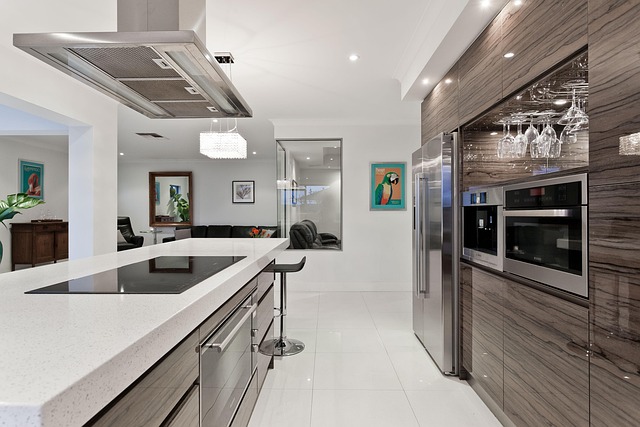LED lighting is a top choice for sustainable kitchen renovations due to its significant energy efficiency (up to 75% less electricity than incandescent bulbs), extended lifespan (thousands of hours), and low maintenance. Smart controls allow precise light levels, enhancing functionality and ambiance in eco-friendly designs. By reducing utility costs and environmental impact, LED lights provide a vibrant, durable solution for food preparation while offering precise intensity and color temperature control, making them ideal for various kitchen tasks and moods. Successful case studies demonstrate LED technology's ability to reduce energy consumption without compromising quality, setting new standards for sustainable kitchen renovations.
“Elevate your kitchen’s efficiency and ambiance with LED lighting—the secret weapon for modern, sustainable home upgrades. This comprehensive guide explores how LED technology is revolutionizing kitchen spaces. From energy-saving benefits to unparalleled brightness, we delve into the advantages of LED lighting in kitchen renovations.
Discover how this innovative approach can enhance productivity while reducing environmental impact, making your kitchen a shining example of sustainability.”
Understanding LED Lighting: Benefits and Advantages for Your Kitchen
LED lighting is transforming the way we illuminate our spaces, and the kitchen is no exception. When considering a sustainable kitchen renovation, LED technology offers a range of benefits that make it an attractive choice for homeowners. Firstly, LEDs are incredibly energy-efficient; they consume up to 75% less electricity than traditional incandescent bulbs, reducing energy costs significantly. This efficiency translates into environmental benefits as well, as it decreases the carbon footprint associated with electricity generation.
Moreover, LED lights have a longer lifespan compared to their conventional counterparts. While traditional bulbs may last for hundreds of hours, LEDs can shine brightly for thousands, reducing the need for frequent replacements. This longevity is a significant advantage in busy kitchens where lighting fixtures are frequently used and subjected to high humidity. With their durability and low maintenance requirements, LED lights offer a practical and cost-effective solution for any sustainable kitchen renovation project.
The Role of Energy Efficiency in Sustainable Kitchen Renovations
In the pursuit of sustainable kitchen renovations, energy efficiency plays a pivotal role in creating eco-friendly and cost-effective spaces. LED lighting emerges as a game-changer in this realm, offering an efficient alternative to traditional bulbs. By consuming significantly less electricity, LED lights not only reduce utility bills but also contribute to a greener environment. Their longevity is another advantage, as they last much longer, decreasing the need for frequent replacements and further saving on costs.
This energy efficiency translates into a brighter, more sustainable kitchen. With proper lighting design, LED fixtures can enhance task performance, improve food preparation, and create a welcoming ambiance. Moreover, integrating smart controls allows for precise adjustments, ensuring optimal light levels throughout various activities, from cooking to dining. Such considerations are key to achieving both functionality and aesthetics in modern, sustainable kitchen renovations.
Enhancing Kitchen Brightness with LED Technology
In today’s quest for energy-efficient and modern homes, LED lighting is revolutionizing the way we illuminate our spaces, especially in the heart of the home—the kitchen. When it comes to enhancing brightness and efficiency, LED technology offers a game-changer for sustainable kitchen renovations. This advanced lighting solution provides a brighter, more inviting kitchen environment while significantly reducing energy consumption compared to traditional lighting methods.
LED lights are renowned for their longevity, durability, and eco-friendly nature, making them an ideal choice for busy kitchens. Their ability to produce vibrant, consistent light throughout their lifespan ensures that meals can be prepared under optimal lighting conditions. Moreover, LED technology allows for precise control over lighting intensity and color temperature, catering to various tasks and moods within the kitchen, from bright, energizing lights for food preparation to softer, warmer tones for cozy dining moments. This versatility contributes to a more comfortable and efficient cooking experience in any sustainable kitchen renovation.
Choosing the Right LED Fixtures for Your Workspace
When planning a sustainable kitchen renovation, LED lighting is an excellent choice for both efficiency and style. The key to success lies in selecting the right LED fixtures tailored to your workspace. Consider factors like lumens (the unit of measurable light), color temperature (warm vs cool tones), and the fixture’s design and placement.
For a kitchen, task lighting is essential, so under-cabinet LED strips or pendant lights focused on work areas are ideal. Opt for daylight-like colors (5000K-6500K) to reduce eye strain and enhance productivity. Additionally, the energy efficiency of LEDs means lower utility bills and a smaller carbon footprint, making them a smart choice for eco-conscious renovations.
Case Studies: Successful LED Lighting Implementations in Kitchens
LED lighting has proven to be a game-changer in numerous sustainable kitchen renovations, offering both enhanced efficiency and brightness. Case studies highlight the successful integration of LED technology in kitchens, showcasing its ability to reduce energy consumption while providing superior illumination. In one such example, a family undertook a kitchen renovation aimed at increasing energy efficiency. They replaced traditional incandescent bulbs with LED lights, resulting in a 50% reduction in energy usage without compromising on lighting quality.
The implementation included under-cabinet LED strips and recessed lights, creating a bright and inviting space. This transformation not only reduced the family’s carbon footprint but also lowered their utility bills significantly. Another study featured a commercial kitchen that adopted LED lighting as part of a broader sustainability initiative. The new LED system not only met the high illumination standards required for food preparation but also contributed to a 30% decrease in overall energy expenses, setting a benchmark for future sustainable kitchen renovations.
LED lighting emerges as a powerful tool for transforming kitchens into vibrant, energy-efficient spaces. By adopting LED technology, homeowners and renovators can achieve both enhanced brightness and remarkable energy savings, contributing to a greener, more sustainable kitchen environment. The case studies presented demonstrate that strategic LED implementations can significantly improve workspace efficiency and ambiance, making it a top choice for those seeking to revolutionize their kitchens while minimizing environmental impact in the process.
